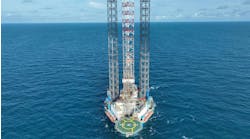David Paganie
Managing Editor
ATP Titan, claimed to be the first deepwater dry tree drilling and production platform built in the US, was christened at Gulf Island Fabrication’s south yard in Ingleside, Texas, recently, underscoring the industry’s continuing innovation in new technology.
The $600-million ATP-operated MinDOC platform hull was fabricated on its side in a purpose-built graving dock, measuring 600 ft (183 m) long, 250 ft (76 m) wide, and 40 ft (12 m) deep. The $25-million dock is the first in the US built for offshore construction. This month, the 19,000-ton (17,237-metric ton) platform hull is scheduled to float off the dock and be towed to sea, a process that is expected to take about two weeks. The topside module will be mated with the hull offshore in November.
The platform will be installed in 4,000 ft (1,219 m) of water to service the Telemark Hub in the Gulf of Mexico, which consists of three fields: Mirage (Mississippi Canyon block 941) discovered by Vastar in 1991; Morgus (Mississippi Canyon block 942) discovered by Shell in 2000; and Telemark (Atwater Valley block 63) discovered by Texaco in 2000. ATP acquired the three fields in August 2006.
Long-time supporter of the MinDOC, Robert Shivers, VP Projects, ATP Oil & Gas, said the company had to move quickly into development. “The licenses had expired or were about to expire and the only way to preserve them was to get moving with a development concept. ATP had been in this position before, but the challenge was the properties were in 4,000 ft of water with no pipeline infrastructure.”
ATP’s vision was to develop the Telemark Hub with MinDOC 3, the third generation of the Minimum Deepwater Operating Concept, due to the unavailability of infrastructure in the vicinity and its design advantages over competing concepts, said Paul Bulmahn, chairman and CEO of ATP Oil and Gas.
“ATP selected the MinDOC for its light weight, cost-effective, deepwater design, which looks like a semisubmersible but behaves like a spar in terms of stability and dynamic response to waves. It provides a higher load capacity and enhances stability over previously designed semisubmersibles or spars.”
Its risers are tensioned by a hydraulic system rather than air cans or buoyancy cans commonly used on spars. It incorporates six dry tree wellheads with three pairs of future subsea flowlines. The platform supports full drilling capability, and a processing capacity of 25,000 b/d of oil and 50 MMcf/d of natural gas, with expansion to 100 MMcf/d of natural gas.
“This endeavor took a company with only 63 employees to make it happen, to make this project economically viable,” Bulmahn said.
Bluewater Industries, the general contractor for the project, hired Gulf Island Fabrication on behalf of ATP to build the hull and topsides.
“We had almost 2,000 employees that worked on this project, and I’m proud of all of them,” said Kerry Chauvin, chairman and CEO of Gulf Island Fabrication. About 16,000 tons (14,515 metric tons) of topsides were built at the company’s facilities in Houma, Louisiana.
“It started about 10 years ago when our company realized that the shallow water GoM would be non-existent within the next few years, so we began to explore ways to get more into the deepwater. We developed our facilities to handle very heavy loads.
“There were many challenges to overcome in this particular project. It was on a fast-track, what we call design while fabricating, which is everyone’s nightmare, especially for a fabricator.”
The flexibility of the design during the construction process is one of the concept’s strengths, William Bennett, president of Bennett and Associates, said on the sidelines of the event. Bennett designed MinDOC 3 which was initially conceived by Alden “Doc” Laborde. Laborde holds a portfolio of inventions, including the first transportable semisubmersible rig and the first supply boat.
Industry is increasingly concerned over new infrastructure in the GoM withstanding hurricane-force conditions since Katrina and Rita wreaked havoc, but Bennett said the structure is designed to handle what a Katrina-type storm can dish out. “This is the first structure for the GoM designed to the new criteria following Katrina, the first structure for the central region in the GoM which is the most hostile area, and it’s the first structure that can be moved from site to site.” The platform will be held in place by a 12-point mooring system designed for 100-year storm conditions.
ATP Titan will first produce Mirage and Morgus, and later redeploy to Telemark. “The entire platform can be reused except the drilling piles,” Bennett said. With an expected life of 40 years, ATP plans to reuse and redeploy the platform multiple times during its life span.
Bulmahn closed with high expectations. “Telemark Hub will more than double ATP’s production beginning in 2010.”
Shortly thereafter, ATP announced that it discovered additional pay sands at Mirage. The well encountered 266 ft (81 m) of net pay, more than tripling the pre-drill estimates, the company said. The original discovery well on Mirage hit 87 ft (27 m) of net pay.




